Ground Reports
Decoding Odisha’s Endemic Conundrum Of Its Poorest Living In Its Richest Tracts — Ground Report From Sundargarh
Jaideep Mazumdar
May 19, 2024, 02:17 PM | Updated 07:18 PM IST
Save & read from anywhere!
Bookmark stories for easy access on any device or the Swarajya app.
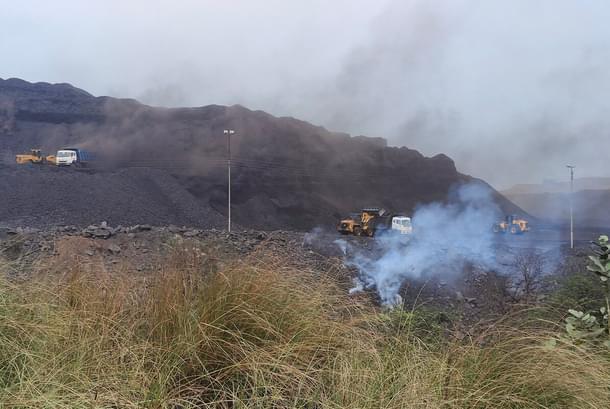
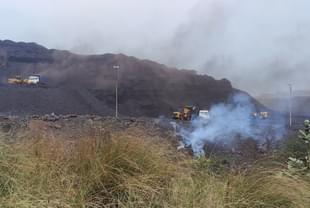
Sundargarh, the headquarters of Odisha’s northwestern district that goes by the same name, is quite nondescript. It is dusty, provincial, littered and lacking in many civic amenities, like many other district towns in the state.
But what sets its apart from other towns in Odisha’s remote districts are the tell-tale signs of pockets of enormous prosperity: glitzy stores stocked with high-end furnitures and bathroom fittings, palatial bungalows tucked away behind high and forbidding boundary walls and, occasionally, luxe cars and SUVs zipping down its roads.
Mercedes, Audis, BMWs, Range Rovers and Toyota Land Cruisers are not an uncommon sight in Sundargarh. But they do elicit stares, especially from the desperately poor who populate the district.
In terms of resources, Sundargarh district is the richest in the state and is the top revenue earner for Odisha — it contributes nearly ten per cent of the State Gross Domestic Product (GSDP). The district’s annual per capita income of Rs 8.64 lakh is the highest in the state and nearly six times that of the state's annual per capita income of Rs 1.49 lakh.
Sundargarh district’s GSDP is over Rs 28,67,856 lakh, again the highest amongst all the districts in the state. It is a treasure trove of minerals like iron ore, manganese, limestone, dolomite, silica sand, bauxite and coal, and almost one-third of the state’s mineral resources are concentrated in this district alone.
The district has about 14,000 industrial units, of which nearly 90 are large ones that employ over 55,000 workers. About one lakh people are employed in over 13,000 small industrial units.
Sundargarh hosts steel and cement manufacturing plants, ceramic and machine-making units, and many other major industries. It also has a large number of mines.
But Sundargarh, a tribal-majority district, is one of the poorest in not only Odisha, but also India. Though the state’s official figures put poverty at nearly 40 per cent, it is estimated that more than 45 per cent of Sundargarh’s population, especially its tribals and Scheduled Castes (SCs), live below the poverty line.
The poor of Sundargarh cannot afford two nutritious meals a day, and the incidence of starvation and diseases resulting from malnutrition are very high.
This high level of poverty in a district which contributes so much to the state’s economy represents an abject failure of governance on part of the state government. It is evident that even a small portion of the revenue earned by Odisha from this district is not ploughed back for the welfare of the poor here.
It is also evident that the District Mineral Fund (DMF) and the ‘Pradhan Mantri Khanij Kshetra Kalyan Yojana’ (PMKKKY) (read the latest guidelines here) — that obligate mining companies to pay a share of their profits (apart from royalty) to the state government for implementing various welfare schemes and development projects for people directly or indirectly affected by mining — have not been utilised properly. Had that been done, nearly half the people of Sundargarh would not have had to live in such abject poverty.
Visit to Babupara
To get a first-hand account of the terrible conditions of the people, especially the tribals, who dwell near the mines, I travel to the curiously named Babupara village about 65 kilometres west of Sundargarh town.
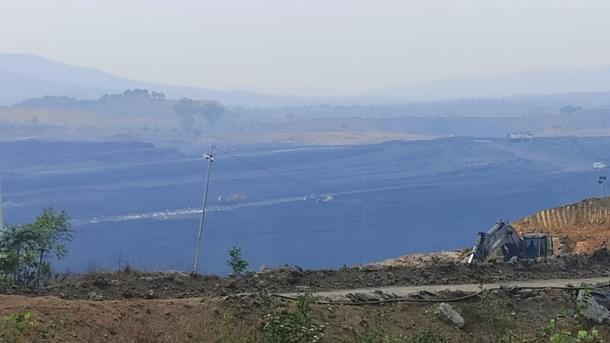
The journey to Babupara, which is accessible through an unpaved 3-kilometre mud track leading off the cratered, dusty and busy Sundargarh-Gopalpur Highway, takes about two hours. That’s because of the poor condition of the highway on which thousands of overloaded trucks carrying mountains of freshly excavated coal, iron ore and other minerals ply every day.
A thick layer of black coal dust hangs heavy over the highway and up to half a kilometre on its flanks. Everything is covered in black.
I meet Chaitanya Sekia who has come to the highway to see off his wife who is going to attend the marriage of a relative.
Sekia, who belongs to the Gond tribe, owns a 1.2-acre plot of farmland on which he cultivates paddy. But farming, he says, has become very difficult after a coal mine started operations near his small village of 15 households.
Two ponds from which he drew water for his farmland have dried up after the coal mine was commissioned. “The groundwater level has fallen drastically and even the four handpumps in our village don’t yield any water,” Sekia told Swarajya.
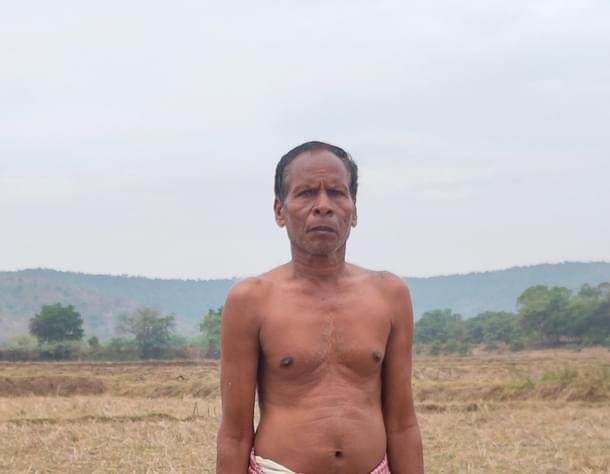
He can grow only one crop a year because of a lack of irrigation facilities. Only about 21 per cent of the district’s farmlands have irrigation and the rest are dependent on the monsoons and water stored in ponds.
The yield from his farmland goes to feed his family of seven — his wife, son, daughter-in-law, a daughter who’s estranged from her husband and three grandchildren. “But that is not enough and only the five kilograms of rice per head provided by Prime Minister Modi keeps us alive,” said Sekia.
His wife gets an old-age pension of Rs 500 a month, and the womenfolk of his family collect tendu leaves that provide an additional income of a couple of thousand Rupees a month.
I asked him if the mining of minerals in his area benefited him. “Not at all,” he says. “My son was refused a job as a labourer in the mine. Locals do not get jobs,” he said.
This is a recurring complaint among all villages in the mining belt. The salary of an entry-level job of a labourer in a mine is at least Rs 20,000 and locals would have benefited immensely. But very few local villagers get jobs.
That, mining companies admit unofficially, is because of the fear of unionisation of labour. The communist parties — the CPI and CPI(M) — have a presence among the locals and providing jobs to locals could lead to quick unionisation of the labour force.
Since the two communist parties have a long history of promoting irresponsible trade unionism, mining companies are wary of providing them a chance to increase their influence.
Mining has actually had an adverse effect on tribals and others living in the mining belt. Apart from the depletion of groundwater and the obvious air and water pollution and general degradation of the environment, locals say their houses also suffer damage due to frequent blasting in the mines.
Phaguram Rana, 43, shows the cracks that have developed in the mud walls of his hut. A portion of the roof over his front verandah caved in recently.
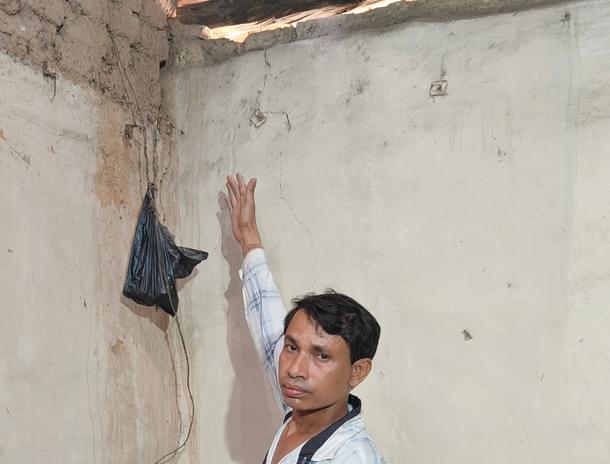
“We live in dread of the blasts that start at 2 pm every day. We have told our panchayat pradhan and local government officials about the damages to our houses, but they are not bothered,” said Phaguram, a daily wage earner who has a family of seven — his wife and him, their two children, his aged parents and a specially-abled brother to support.
“I work as a daily labourer in construction sites and earn about Rs 250 to Rs 300 a day. But on many days, I do not get any work and have to sit idle. On many days, we (the entire family) have only one meal,” says Phaguram.
Prakash Majhi, 35, has a half-acre plot of land where he cultivates one paddy crop a year. The yield can feed his family of five — husband, wife, two children and a widowed mother — for four to five months.
He also has to work as a labourer. The hard work that he puts in, along with malnourishment, has made him a tuberculosis patient. He is not alone — a large number of adults and even children living in the mining belt suffer from tuberculosis and other diseases, including asthma.
Majhi’s elder son, Tushar, a student of class 6, is good in his studies and scored 90 per cent marks in the last annual exams. But, says his father, he is not sure how long he can afford to study.
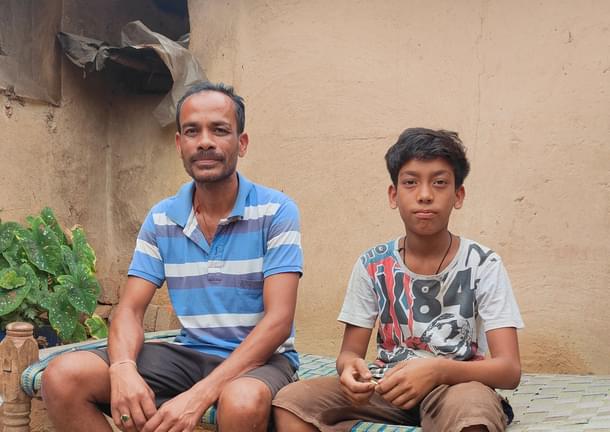
Most kids drop out of school to work in their farmlands or as labourers. “We cannot afford to have them studying after they cross a certain age. As soon as they reach the age when they can work, we have to ask them to discontinue their studies. It’s heartbreaking, especially when the kids want to continue going to school. But that’s the way life is,” says Rina Patel, a mother of two sons and a daughter.
Rina’s husband Umesh is a labourer. She is clad in a tattered saree, but refuses to be photographed in it; she changes to a cotton saree that is one of her very few earthly possessions before posing for photos with her husband.
A portion of the wall of Rina’s kitchen caved in during a blast at a mine about three kilometres away. “Had I been cooking, I would have been injured or even killed,” she said.
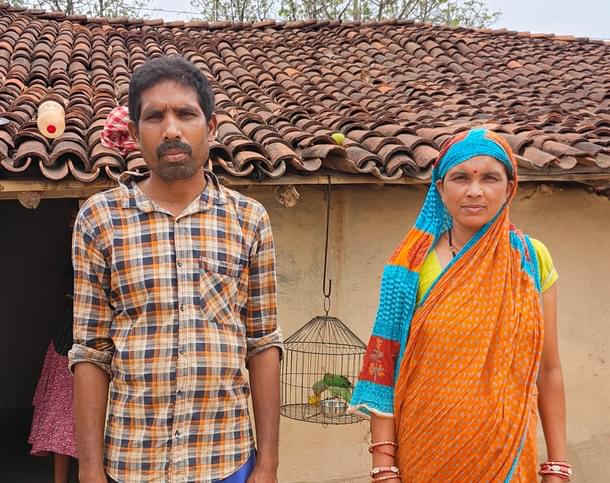
Babupara, like all other villages in the mining belt, suffers from an acute shortage of water. The village has four deep tube wells that were installed some ten years ago. But none of them have been working for the last two years because the groundwater level has gone down.
But every year, the non-functional hand pumps are given a fresh coat of the official green paint. “When we ask the officials what is the point in painting the hand pumps, they tell us they will send men to repair them the next day. That day never comes,” he said bitterly.
The villagers have to depend on a well they have sunk for their drinking water needs. “The sarpanch sends water tankers at times, but that’s very erratic. We take a bath only once or twice a week. The village ponds have also run dry. It’s always been a tough life for us, but after the mines in the nearby areas were commissioned, life has become tougher,” says Umesh Patel.
Sebati Rana says the acute water shortage has made her life miserable. “I have to make frequent trips to the well about half a kilometre from my house (on the outskirts of the village) to fetch water for my ailing father-in-law. He soils his bed and clothes a few times a day, and washing them is a major issue,” she told Swarajya.
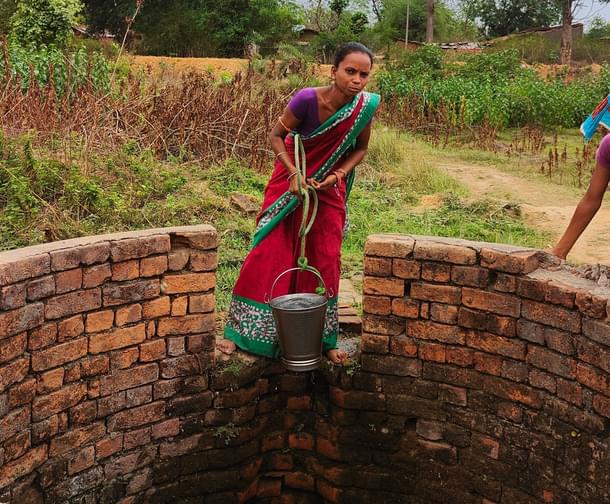
The lack of any progress in the village angered Sebati so much that she floated the idea of boycotting the ruling Biju Janata Dal (BJD) in the simultaneous Lok Sabha and Assembly elections (on Monday, May 20).
“We all agreed. We had a meeting of representatives of all 14 villages under Tumulia gram panchayat and everyone agreed to unanimously boycott the BJD and also abstain from voting. We have conveyed our collective decision to the local BJD workers,” said Prakash Majhi.
“No BJD leader has come to visit our village. They are arrogant,” said Phaguram.
Some BJP functionaries visited the village and requested the locals to withdraw their poll boycott. “But we refused. We told them that we want development here first,” said Sebati Rana.
Babupara’s sorry plight is representative of that of all villages in the large swathes of this district where the land has been gouged out to extract precious minerals from its bowels.
No benefits from the District Mining Fund
Though the laws mandate that a handsome portion of the profits from mining are invested in improving the lives of the locals and mitigating the damage caused to the environment due to mining, it is apparent that nothing much has been done by the state government.
The primary responsibility of using the District Mineral Fund (DMF) to implement welfare schemes and projects as laid down in the PMKKKY guidelines rests with the state government. The mining companies are also mandated to implement welfare projects on their own in their areas of operation as per Corporate Social Responsibility (CSR) guidelines.
But nothing has happened on the ground. Villagers continue to live in crumbling mud huts; pucca concrete houses have not been built for them as mandated under the PMKKKY. They don’t have access to drinking water, proper healthcare and education facilities.
And far from being provided livelihood opportunities through skilling and institutional support for micro-enterprises, the only employment opportunity available to them — in the mines — is denied to them. No initiatives have been made to bring their farmlands under irrigation or provide other support to increase their farm yields.
The infrastructure in the entire area is in shambles, and it is apparent that the measures taken by mining companies and the state government to mitigate the huge damage to the environment caused by mining are lame and ineffective.
Babupara is only one sorry example of how, despite the huge wealth extracted from the mines, the local people have remained desperately poor.
Initiatives of the Union Government help the people get through their days. Many of the poor tribals of Sundargarh are drawing the benefits from Central schemes.
According to official statistics, 14.8 lakh people in Sundargarh benefited from ‘Pradhan Mantri Garib Kalyan Anna Yojana’ last year, while nearly 1.35 lakh houses were built under the PM Awas Yojana over the last ten years.
All households in the district are now covered by the PM Jan-Dhan Yojana, and nearly 10.9 lakh accounts have been opened under the PM Mudra Yojana. Nearly 2.2 lakh tap connections have been provided in the district under the ‘Jal Jeevan Mission’ over the last five years, but these are concentrated in the urban areas.
BJD’s refusal to allow Central schemes:
The BJD government has refused to allow the implementation of this scheme in most villages (like Babupara) out of fear that the beneficiaries will start supporting the BJP! That is why the state government has not allowed the Pradhan Mantri Ujjwala Yojana (LPG connections) to most villages and the district has only 33,280 connections under this scheme over the last nine years.
The state’s refusal to allow tribals and the poor and backward to avail of the benefits of Central schemes is also the reason why Sundargarh has just 1428 registered beneficiaries under the Ayushman Bharat Yojana (health insurance scheme), less than 20,000 soil health cards, less than 17,000 enrollments under the Pradhan Manti Kaushal Vikas Yojana (read this) — a flagship skill development scheme — and just a little over 21,000 beneficiaries of the National Apprenticeship Promotion Scheme.
Patuadihi Village
I visited another village — Patuadihi under Giringkila Gram Panchayat of Lephripada development block of the district — that’s not located near any mine.
The condition of the villagers there was as depressing as that of Babupara. There’s acute farm distress caused by lack of irrigation, low procurement prices, the rising cost of farm inputs, a lack of employment and livelihood opportunities, malnutrition and high indebtedness.
Naroj Pandey and his father Toshanand grow paddy in their 1.5 acre farmland. “In a good year, my yield is 12 quintals and though the price at the mandi is Rs 2100 per quintal, we get much less. The mahajans (big traders) find some excuse or the other to give us much less,” he told Swarajya.
The state introduced groundnut cultivation to supplement farm incomes last winter. But the quality of seeds it provided was very poor, as a result of which the yield was also poor.
Phagulal Gurulia, 39, regrets cultivating groundnuts. “I put in a lot of labour, but it was all futile. The crop did not get me enough money to even cover half the cost of growing it,” he said.
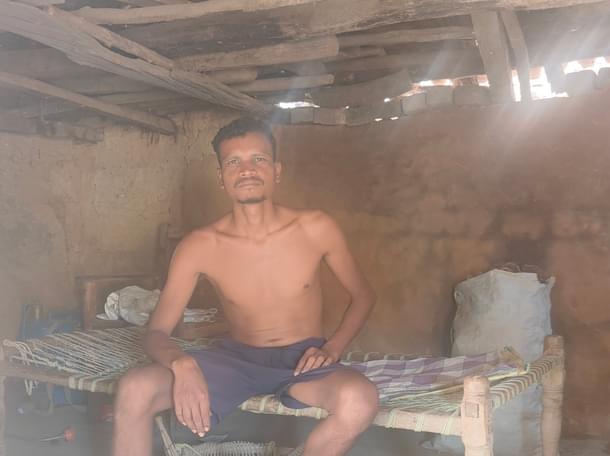
Many villagers, like Phagulal, don’t have a ration card. His name was also inexplicably deleted from the list of Pradhan Mantri Awas Yojana (PMAY) beneficiaries.
Nibas Patel, 34, applied for a ration card some five years ago but has not got it as yet. “I’m told every time that my application is on hold. And without the ration card, I don’t get any facilities from the government,” he said.
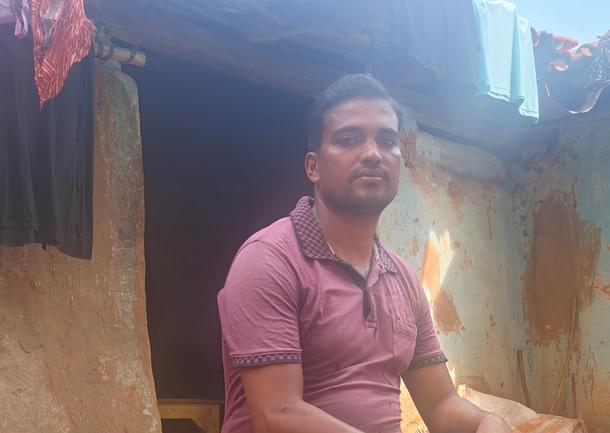
The 18 quintals of paddy that Chandramani Bariha, 30, gets from his 1.5 acre of unirrigated, rain-fed farmland, is not enough to feed his family of eight. He depends on the Rural Employment Guarantee Programme (MGNREGA), but the wages are disbursed irregularly.
“We don’t get paid before four months. So I have to borrow from the local moneylender at very high interest rates (5 per cent a month) to take care of my family. I am heavily indebted to the moneylender and if my son (14 years old) doesn’t start earning soon, I will have to sell off my land to repay my debt,” he told Swarajya.
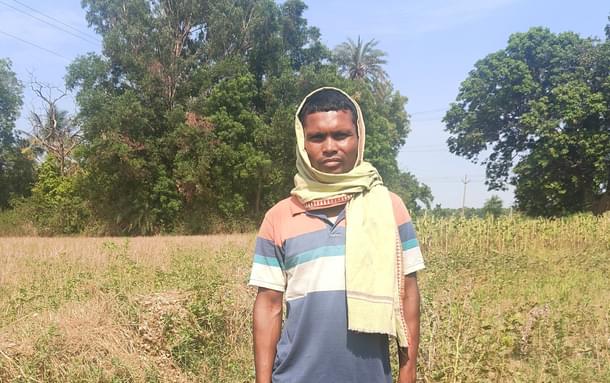
Abhin Chandra Pandey, 51, said that few in the village of more than 300 households have got houses under the PMAY. “The list is prepared by state government officials and it is very arbitrary,” he said.
However, all the villagers acknowledge that it is the Central schemes like free rations, pensions for the elderly etc that they manage to sustain on. “Had these Central government schemes not been there, we would have starved to death,” said Toshanand Pandey.
Toshanand is one of the very few lucky ones in his village — he has got a concrete house under the PMAY.
But, asserts Union Tribal Affairs Minister Jual Oram, the poverty-stricken and development-deprived people of Sundargarh need not depend on their luck to avail benefits that are rightfully theirs.
“I am urging people to vote for Narendra Modi again in Delhi and for a change in government in the state. Only then can Sundargarh, and Odisha, develop,” said Oram, who is aiming at a hat-trick from Sundargarh.
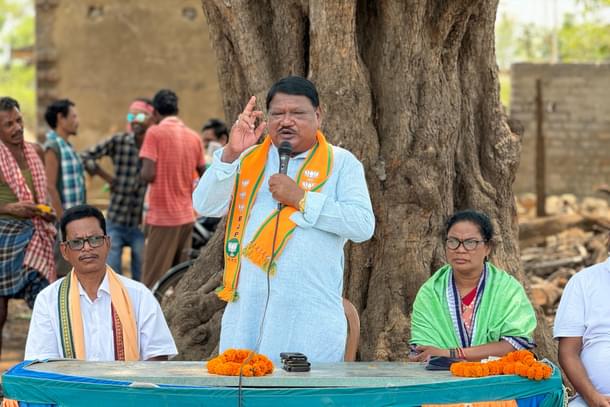
Oram won this Lok Sabha seat in 1998, 199 and 2004, but lost it in 2009. He won again in 2014 and 2019, the last time by a huge margin of 2.23 lakh votes.
Oram, who was one of the first elected representatives from the BJP in Odisha — he was elected MLA for the first time in 1990 — and has been responsible for the growth of the party in the state, had been making an emotional appeal to his constituents.
“This is the last time I am contesting elections. I want to see Sundargarh develop and the people here leading comfortable lives with Narendra Modi as the Prime Minister and a BJP leader as the Chief Minister. I am appealing to the people of Sundargarh to grant me this last political wish of mine for their own benefit,” said Oram, 63.
Oram’s appeal has touched the hearts and minds of the people of Sundargarh. Not just because it is an emotional one from a tall leader of this constituency, but also because it is a practical one. Naveen Patnaik has done little for Sundargarh in the 24 years that he has been in power, and has blocked many Central schemes from being implemented.
Only a ‘double engine sarkar’ can ensure rapid development of the people of Sundargarh — provide them decent houses to live in, clean water to drink and clean air to breathe, livelihood opportunities, increase in farm income and proper healthcare and education.
This report is part of Swarajya's 50 Ground Stories Project - an attempt to throw light on themes and topics that are often overlooked or looked down. You can support this initiative by sponsoring as little as Rs 2,999/-. Click here for more details.





